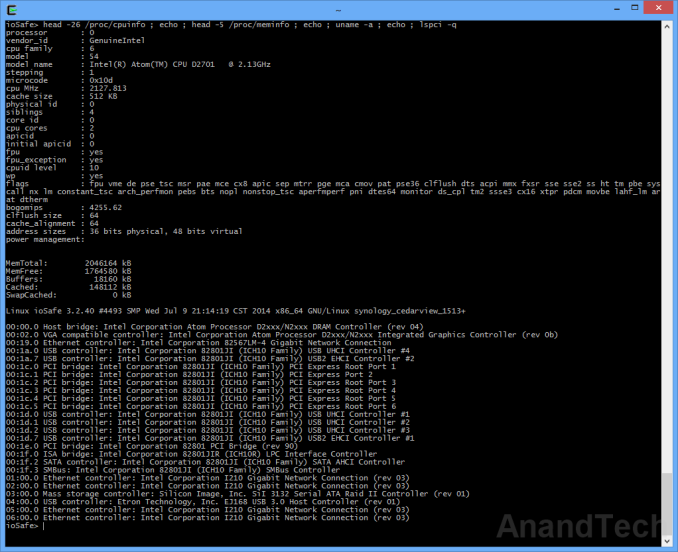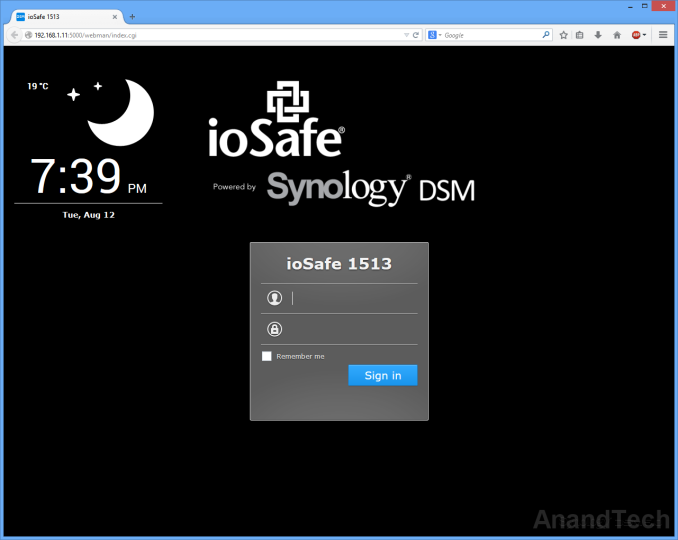ioSafe 1513+ Review: A Disaster-Resistant Synology DS1513+
by Ganesh T S on August 13, 2014 7:30 AM EST- Posted in
- NAS
- Storage
- Synology
- Enterprise
- ioSafe
Chassis Design and Hardware Platform
The Synology DS1513+ has been around for more than a year now. ioSafe announced the disaster-resistant version back at CES and tentatively set the shipment date for March. However, it wasn't until late July that the design was finally perfected. Compared to the SoloPRO and the ioSafe 214 platforms, the 1513+ is quite different when it comes to power consumption and thermal requirements. Tackling the heat dissipation was one of the main challenges faced by ioSafe in the product development process.
ioSafe uses three main patented technologies in disaster-proofing the 1513+:
- HydroSafe: Waterproofing by placement of drives in a metal cage sealed with rubber gaskets.
- DataCast: Fireproofing by surrounding the drive cage with a super-saturated gypsum structure
- FloSafe: Vents in the gypsum structure to allow for cooling during normal operation.
ioSafe has a technology brief explaining how these are applied in the 1513+. It is reproduced below:
In traditional NAS units / storage arrays, the arrangement of the fans has to ensure that air flows across the surface of the drives in order to cool it down. This is not directly possible in the ioSafe NAS designs because the hard drives are inside a waterproof sealed chamber. Ambient air is not designed to enter the waterproof chamber, but, through the fireproof door and to the outside of the extrusion. For cooling purposes, the design relies on a combination of conduction (from the drives to the extrusion) and convection (from the extrusion to the ambient air flowing over the extrusion). Note that the waterproof front door of the drive cage as well as the fireproof front face are essential parts of the cooling mechanism. Without these, the airflow across the serrated drive cage might not be enough to draw away the heat through the fans.
On the software front, the ioSafe 1513+'s Synology DSM is based on a Linux kernel (v 3.2.40). The interesting aspects of the hardware platform can be gleaned after accessing the unit over SSH.
Note that the unit has four Intel I210 GbE NICs connected via PCIe. The USB 3.0 ports are from an Etron EJ168 PCIe x1 to 2x USB 3.0 bridge,while a SiI 3132 PCIe x1 to 2x eSATA host controller with port multiplier support enable the two eSATA ports (to which the expansion chassis units get attached). Since the system utilizes the ICH10 I/O controller hub (this is the standard Cedarview storage platform that Intel promoted a few generations back), all the SATA ports for the drive bays come off the hub without the need for any bridge chips.
Our review unit came with the drives pre-initialized in a SHR volume (1-disk fault tolerance). ioSafe has a special wallpaper for the web UI, but, other than that there is no customization - all DSM features that one might get after initializing the unit from a diskless configuration are available in the pre-installed version also.
We have covered DSM 5.0's setup and usage impressions in our recent DS214play and DS414j reviews. There is not much point in rehashing the same excellent setup and usage experience. That said, each of those reviews concentrated on a particular DSM aspect, and this review will be no different. After the sections presenting the performance numbers, we will take a detailed look at the iSCSI features of DSM 5.0.













43 Comments
View All Comments
Howard - Saturday, August 16, 2014 - link
I don't know about anyone else, but the "3-2-1 rule" sounds really dumb, especially when the "1" means that you should have the data in TWO different physical locations.jaden24 - Friday, August 29, 2014 - link
But can it survive a fire, a flood, and still serve up the game Crysis?Mike Kobb - Tuesday, December 16, 2014 - link
In your closing paragraph, you comment on the fan noise as making the unit suitable for an air conditioned server room.I couldn't find any other mention of fan noise in the review. Is it significantly louder than the Synology 1513+ fans? Are they loud under all circumstances, or only when the ambient temperature is high or the unit is heavily loaded? The ioSafe web site lists a range of 25-59 db(A), which is an enormous spread.